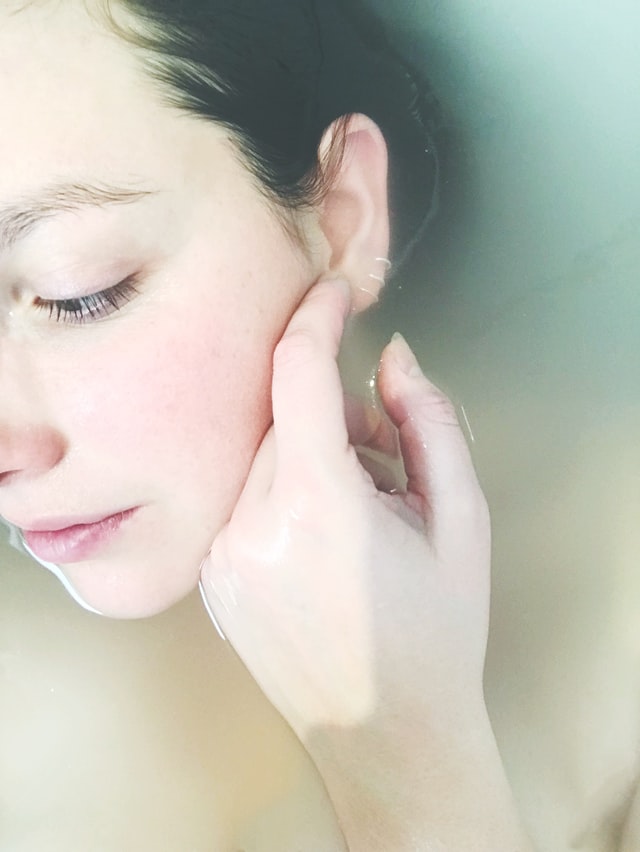You're probably aware that having acne-prone skin requires extra care, but you might be surprised to learn that a consistent nighttime moisturizing routine can be a total game-changer. By following a few simple steps, you can wake up to clearer, healthier-looking skin. It all starts with proper cleansing and occasional exfoliation, but what comes next is just as vital. As you establish your nighttime routine, you'll want to know the specific products and techniques that'll help you achieve the best results, and that's where things get interesting.
Cleanse Your Skin Properly
You start your nighttime moisturizing routine by washing your face with a gentle cleanser that effectively removes dirt, oil, and makeup without stripping your skin of its natural moisture. You're looking for a cleanser that's formulated for your skin type, whether it's normal, dry, oily, or combination. As you massage the cleanser onto your face, you make sure to cover all areas, including your hairline, jawline, and the sides of your nose. Rinse your face thoroughly with lukewarm water, making sure to remove all residue.
Next, you pat dry your face with a clean towel, being gentle not to rub too hard. Don't scrub your skin with the towel, as this can irritate it and lead to breakouts. If you have acne-prone skin, you might be tempted to use hot water to try to deep clean your pores, but resist the urge. Hot water can strip your skin of its natural oils, leading to dryness and irritation. Instead, stick with lukewarm water and a gentle cleanser to keep your skin balanced and healthy. By cleansing your skin properly, you're setting yourself up for a successful nighttime moisturizing routine.
Exfoliate Twice a Week
Exfoliating twice a week is a crucial step in removing dead skin cells and unclogging pores, allowing moisturizers to penetrate more deeply and effectively. By doing so, you're helping to prevent clogged pores and breakouts, which is especially important for acne-prone skin. You can use a physical exfoliant like a gentle scrub or a chemical exfoliant containing alpha-hydroxy acids (AHAs) or beta-hydroxy acids (BHAs). Choose one that suits your skin type and concerns.
When exfoliating, be gentle and focus on areas that tend to get clogged, like the T-zone. Massage the exfoliant onto your skin for about 10 seconds, then rinse with lukewarm water. Don't overdo it – you want to remove dead skin cells, not strip your skin of its natural oils. Be consistent and stick to exfoliating twice a week, as over-exfoliating can lead to irritation and dryness. By incorporating exfoliation into your nighttime routine, you'll be giving your skin the best chance to absorb your moisturizer and wake up looking healthier and more radiant.
Tone With Witch Hazel
Following exfoliation, toning with witch hazel helps balance your skin's pH and tighten pores, preparing it for the next steps in your nighttime moisturizing routine. You're probably wondering how witch hazel can benefit your acne-prone skin. The answer lies in its antibacterial and anti-inflammatory properties, which help reduce redness and prevent future breakouts. When you tone with witch hazel, you're fundamentally giving your skin a deeper cleanse and setting the stage for better absorption of subsequent products.
To incorporate witch hazel into your routine, simply soak a cotton pad with the solution and sweep it across your face and neck. Be sure to avoid the delicate skin around your eyes. Don't rinse your skin afterward; instead, let the witch hazel dry completely before moving on to the next step. By toning with witch hazel, you're taking a proactive approach to managing your acne-prone skin and creating a more balanced complexion. With consistent use, you may start to notice a reduction in acne and an overall improvement in your skin's texture and appearance. Your skin will thank you for this simple yet effective addition to your nighttime moisturizing routine.
Use a Hydrating Serum
Now that your skin is toned and balanced, a hydrating serum can help lock in moisture and provide an intense dose of nourishment to leave your skin feeling soft, supple, and rejuvenated. You'll want to choose a serum that's packed with ingredients like hyaluronic acid, glycerin, or ceramides, which are all known for their ability to attract and retain moisture. When you apply a hydrating serum, you're fundamentally giving your skin a drink of water that will help to quench its thirst and leave it feeling refreshed and revitalized.
As you massage the serum into your skin, take a moment to appreciate the way it absorbs quickly and easily, leaving no greasy residue behind. This is especially important for acne-prone skin, which can be prone to clogged pores and breakouts. By using a hydrating serum, you're helping to create a healthy and balanced skin environment that's less likely to become irritated or inflamed. So go ahead and give your skin the gift of hydration – it will thank you!
Apply Spot Treatment Gels
A few strategically placed dabs of spot treatment gel can make all the difference in tackling specific skin concerns, such as acne, redness, or hyperpigmentation, that your serum and moisturizer may not be able to address on their own. You're targeting these concerns with a concentrated dose of active ingredients, which can lead to faster and more effective results. Look for gels containing salicylic acid, benzoyl peroxide, or niacinamide, which are known for their ability to unclog pores, reduce inflammation, and improve skin elasticity.
When applying spot treatment gels, remember to use them sparingly. A little goes a long way, and overapplying can lead to dryness, irritation, or clogged pores. Use a small amount (about a pea-sized amount) and gently pat it into the affected area with your ring finger. Avoid rubbing or scrubbing, as this can irritate the skin further. Allow the gel to absorb fully before moving on to the next step in your routine. By incorporating spot treatment gels into your nighttime moisturizing routine, you'll be taking a proactive approach to addressing specific skin concerns and wake up to clearer, healthier-looking skin.
Seal With a Lightweight Moisturizer
What's the final step to locking in all the benefits of your nighttime skincare routine – and prepping your skin for a restful night's sleep? You'll want to seal everything in with a lightweight moisturizer. Now, you might be thinking, "But won't moisturizer clog my pores?" Not if you choose the right one! Look for a non-comedogenic, oil-free moisturizer that's specifically formulated for acne-prone skin. This will help hydrate your skin without exacerbating breakouts.
When applying your lightweight moisturizer, use a gentle, upward motion to cover your entire face. Make sure to avoid pulling or tugging on your skin, as this can cause irritation and even lead to wrinkles. Instead, let the moisturizer absorb fully into your skin, providing a soft, supple base for the night ahead. By sealing in your previous skincare steps with a lightweight moisturizer, you'll be helping your skin to repair and rejuvenate itself overnight, setting you up for a brighter, clearer complexion come morning.
Lock It in With Eye Cream
To take your nighttime skincare routine to the next level, focus on the delicate skin around your eyes, where a rich, nourishing eye cream can help target fine lines, dark circles, and puffiness. You don't need much – a pea-sized amount for each eye will do. Gently pat the eye cream into the skin, starting from the inner corner and working your way outward. Be careful not to pull or tug, as this can irritate the skin and cause wrinkles.
Choose an eye cream that's specifically formulated for your skin concerns. If you're struggling with dark circles, look for a cream with caffeine or peptides. For fine lines and wrinkles, opt for a cream with retinol or hyaluronic acid. And if puffiness is your main concern, try a cream with soothing ingredients like chamomile or green tea. Remember, consistency is key. Use your eye cream every night, even if you're tired or in a hurry. With regular use, you'll start to see noticeable improvements in the skin around your eyes, and your entire face will look smoother and more radiant.
Keep Your Hands Away
Your hands can be your skin's worst enemy at night, as touching or picking at your face can transfer dirt, oils, and bacteria from your fingers to your freshly cleansed skin. You've worked hard to get your skin clean, so don't undo all that effort by absentmindedly touching your face. Try to be mindful of your hands' whereabouts, especially when you're getting ready for bed.
One way to keep your hands occupied is to engage in a relaxing activity before bed, like reading or listening to calming music. This will distract you from any temptation to touch or pick at your skin. You can also wear gloves to bed if you tend to scratch or pick in your sleep. It might feel silly, but trust us, your skin will thank you. By keeping your hands away from your face, you'll avoid transferring bacteria and oils, which can clog your pores and lead to acne. Give your skin a break and let it be – it's working hard to repair itself while you sleep.
Get Enough Sleep Tonight
Now that you've learned to keep your hands away from your face at night, make sure you're giving your skin ample time to reap the benefits of your nighttime moisturizing routine by getting a full night's sleep. When you don't get enough sleep, your skin can become dull, dry, and more prone to breakouts. During sleep, your skin repairs itself and rejuvenates its natural barrier function, which helps to lock in moisture and protect against environmental stressors.
To give your skin the best chance at glowing, aim for 7-9 hours of sleep each night. Establish a relaxing bedtime routine to help you wind down and prepare your body for rest. This can include activities like reading a book, taking a warm bath, or practicing gentle stretches. Avoid screens for at least an hour before bed, as the blue light can interfere with your body's production of melatonin, the hormone responsible for regulating sleep. By prioritizing sleep and combining it with your nighttime moisturizing routine, you'll be on your way to achieving healthier, more radiant skin.
At a Glance
You've made it through the nighttime moisturizing routine for acne-prone skin! By following these simple steps, you're on your way to clearer, healthier-looking skin. Remember to be consistent and patient, as it may take some time to see results. Keep your hands away from your face, get enough sleep, and let the products do their magic. With dedication and the right routine, you can wake up to glowing, acne-free skin every morning.






